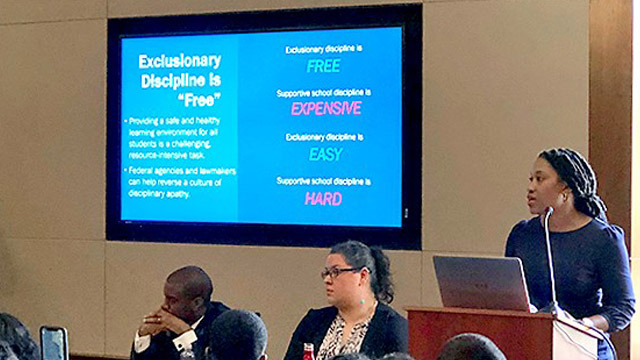The topic of exclusionary discipline is not only of professional interest to me—it’s personal. Helping my son navigate the middle grades was taxing. He attended a school that suspended him for defending himself when a classmate broke his iPad and then punched him during recess to instigate a fight. Even though neither boy was hurt, it was the first behavioral incident for each, and the district boasts a progressive discipline policy that prioritizes “the least severe response that does not result in a loss of academic instruction time,” the school determined that my son should spend a day in a room with an athletic coach doing worksheets. When I disputed the punishment and requested a disciplinary action that would allow him to attend class—citing the many alternatives to classroom removal listed in the policy—I received the reply: “You should be grateful. He could have received 10 days of out-of-school suspension.”
Thereafter, my son fell out of love with school and developed a deep distrust of teachers and administrators. He felt unjustly stigmatized in a school where he perceived that his white peers were not punished but consoled for defending themselves when attacked.
Taking the path of least resistance
I’ve served many school communities over the years as a teacher, educational technology consultant, technical assistance provider, high school track coach, and researcher. I am keenly aware that many of our nation’s schools, school districts, and state education agencies (SEAs) have an incredibly difficult and unenviable task when it comes to providing a safe and healthy environment for all students. I’ve witnessed the negative repercussions of societal failings like gang violence, domestic abuse, malnutrition, drug addiction, inadequate access to affordable health care, and chronic unemployment on the psyches and life ambitions of students. Our schools did not create but have inherited a host of social, economic, political, and historical conditions that influence their ability to educate. That’s an important message for local, state, and federal policymakers to hear, and I was honored to share my experience and expertise with Congress earlier this year.
Addressing challenges like chronic student absenteeism related to neighborhood violence and the disproportionately high assignment of inexperienced instructional staff to high-poverty schools is not inconsequential and should be taken very seriously. When ill-equipped to take on social and economic challenges like these, schools may take the path of least resistance because exclusionary discipline is expedient. After all, exclusionary discipline is “free,” as Johanna Lacoe shared during a Regional Educational Laboratory Mid-Atlantic call in May.
On the other hand, implementing effective behavior management interventions can be expensive and time intensive—particularly tiered interventions that require schoolwide, targeted, and individualized supports like ongoing and embedded professional development and on-site mental health specialists. Alternative disciplinary actions like community service, after-school or weekend detention, peer courts, restorative circles, and prosocial growth counseling all require additional training, expertise, and increased time commitments from school and district personnel who are already spread thin with large classroom rosters and student caseloads.
Exclusionary discipline might have relatively few short-term costs to schools and districts, but its long-term implications come at a great cost to our children and communities. Federal agencies and lawmakers can help reverse a culture of disciplinary apathy in schools and school districts—whether unconscious or explicit—by sharing their acute burden and lightening their load, through championing effective federal programs and initiatives.
Federal investments in school discipline reform
The federal government has made a number of significant investments in initiatives, statutes, and grant programs designed to better understand the issues with and facilitate the adoption of evidence-based alternatives to exclusionary discipline. What follows is not an exhaustive list:
- Project Prevent Grant Program. This federal grant program, funded by the U.S. Department of Education (ED), provides funding to local education agencies (LEAs) to increase their capacity to do the following:
- Identify, assess, and serve students exposed to pervasive violence
- Comprehensive School Safety Initiative (CSSI). Formed by the National Institute of Justice in response to high-profile school violence incidents, CSSI invests in research about the root causes of school violence, develops strategies for increasing school safety, and rigorously evaluates innovative school safety strategies through pilot programs.
- Supportive School Discipline Initiative (SSDI). Launched jointly by the U.S. Departments of Justice and Education in 2014 to stem the school-to-prison pipeline and advance the implementation of positive disciplinary policy in schools nationwide, SSDI sought to do the following:
- Build consensus among key stakeholders about the need for change
- Catalyze research and the systematic collection of school discipline data to improve the education community’s understanding of the differential impact of exclusionary and positive disciplinary approaches on schools and academic outcomes
- Issue interagency guidance to help schools improve their understanding of, and compliance with, civil rights laws and legal disciplinary practices
- Increase the capacity, awareness, and knowledge of educators, justice personnel, law enforcement, and other stakeholders about evidence-based and supportive approaches to school discipline through training and technical assistance
-
Student Support and Academic Enrichment Program. This federal grant program, funded by ED, seeks to improve students’ academic achievement by increasing the capacity of SEAs, LEAs, and local communities to provide all students with access to a well-rounded education improve school conditions for student learning; and improve the use of technology to advance the academic achievement and digital literacy of all students.
-
School Climate Transformation Grant Program. This ED program awards competitive grants to SEAs to develop, enhance, or expand systems of support for, and technical assistance to, LEAs and schools implementing an evidence-based, multitiered behavioral framework for improving behavioral outcomes and learning conditions for all students.
- Ensure that affected students are offered mental health services for trauma or anxiety
- Support conflict resolution programs
- Implement other school-based violence prevention strategies in order to reduce the likelihood that these students will later commit violent acts.
Systemic reform is predicated on changing behavior and beliefs across the entire academic enterprise
Our congressional leaders are instrumental in ensuring the ongoing sustainability of initiatives and programs like these and, importantly, reinvigorating them when they lose fiscal viability due to shifts in political will and priorities. Most recently, the 2018 Federal Commission on School Safety recommended rescinding Obama-era guidance on discipline disparities. A Dear Colleague letter, jointly issued by the U.S. Departments of Education and Justice, formally withdrew the 2014 guidance, effectively upending the aforementioned SSDI within four years of its inception. When federal commitments to improve public education access, opportunity, and outcomes for all students are sensitive to changes in presidential administrations, those investments risk ultimate failure. A growing body of implementation science research has taught us that making schools safer and more hospitable—a goal that is shared regardless of political affiliation—is a complex, time-consuming, resource-intensive, and iterative process. Four years is insufficient time for a federal initiative to take root, develop, provide training and technical assistance to support high-quality implementation, make mid-course corrections in response to local implementation challenges, and demonstrate positive gains.
Furthermore, systemic reform is predicated on changing behavior and beliefs across the entire academic enterprise. That means reaching all school and district personnel who interact with students, including auxiliary staff such as cafeteria and janitorial staff and security guards, and other stakeholders like local school councils and parent-teacher associations. State and local efforts to reduce and eliminate disproportionate impact in school discipline are large in scope, and therefore, dependent on Federal funding.
While the Federal Commission on School Safety’s report wisely upheld the importance of increasing access to mental health services in schools as a violence prevention strategy, additional funding did not follow suit. Dan Domenech, the executive director of AASA, the School Superintendents Association, decried the lack of appropriations as abandoning states as they work to build positive school climates, saying that the report “has limited utility for school leaders and its purported audience, if school leaders lack the resources to fulfill the best practices and recommendations of the report.”
Federal agencies and lawmakers should be schools’ port in a storm
A recently released briefing report of the U.S. Commission on Civil Rights underscored data that out-of-school suspensions are largely exacted for nonviolent behavior. Myths and misconceptions abound. There are no easy answers, no quick fixes, and many unknowns, such as whether school resource officers deter school violence. How to provide an equitable, safe, healthy, and supportive learning environment is a work in progress. However, whether to provide one should not be political fodder on the national stage or the lone pursuit of state and local education agencies.
Federal agencies and policymakers should be a port in the storm for schools and educators. Congress is best situated to assert school discipline reform as a politically neutral concern, to guard against unfunded federal mandates and recommendations, and to empower federal agencies to consistently and vigilantly protect the civil rights of all students.



